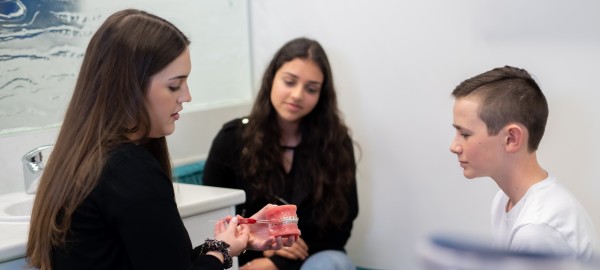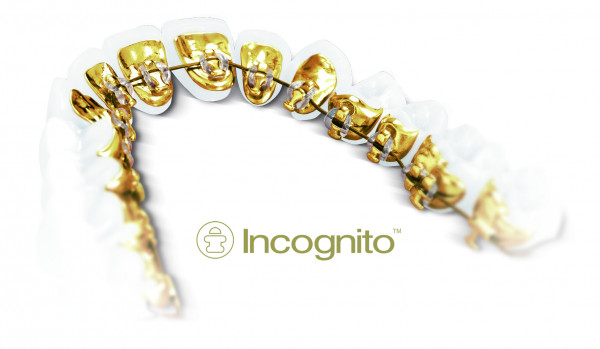
Traditional Metal Braces
Traditional braces are the most common type of braces and are more comfortable today than ever. Made of high-grade stainless steel, these brackets work with thin, metal wires to gently guide the teeth into the correct position. With metal braces, you have the option of adding coloured elastics (rubber bands) for a more unique and colourful smile.
There are many good reasons why time-tested metal braces remain popular —they offer a reliable, effective and economical treatment option. In contrast to the appliances of the past, today's braces are actually smaller, lighter, and more comfortable to wear.
Damon Self-Ligating Metal Braces
Damon Self-ligating braces are made from the same materials as traditional braces. However, they do not use elastic ties. They are the same size as metal braces but use a specialised clip in place of the elastic ties. They require slightly shorter adjustments as there are no elastics to replace.
Clear Ceramic Braces
Ceramic braces are made of clear materials and are therefore less visible on your teeth than metal braces. For this reason, they are used mainly on older teenagers and adult patients who have cosmetic concerns.
Although they are visually less prominent, they require more attention to oral hygiene because ceramic braces are larger and more brittle than their metal counterparts. For these reasons, ceramic braces tend to be used more on upper front teeth than on lower teeth.

Hidden Braces - Incognito Lingual Braces
Lingual braces are hidden behind the teeth. They are customised to match the shape of your teeth; the metal appliances are created uniquely for you. Lingual braces aren't the proper treatment for every orthodontic condition, and they're significantly more expensive than standard braces. They also generally require a bit more time for the wearer to get used to them, and they may prolong treatment slightly. But if you want the least visible type of fixed appliance - and if you're a candidate for this treatment option - then lingual braces may be just what you're looking for.
Frequently Asked Questions about Braces
Braces are placed onto your teeth and with the aid of wires, allows the Orthodontist to move your teeth. There are several different types of braces to choose from, including:
- Clear braces
- Self-ligating braces
- Traditional metal braces
Braces do not often hurt though you may feel a small amount of discomfort for a couple of days as your teeth, gums cheeks and mouth get used to your new braces.
ALWAYS remember to brush your teeth after every meal and floss at least once a day.
- Make sure to use toothpaste that contains fluoride, and ask your orthodontist or family dentist if you need a fluoride rinse. This will help prevent cavities!
- If you take out your retainer to eat, make sure you brush your teeth, floss, and remember to keep the retainer safe in its container so that it does not get lost or broken.
- Keep your retainer clean, too, by brushing it gently with a toothbrush and toothpaste. You may also soak it in denture cleaner as instructed by your orthodontist. Do not put your retainer in boiling water or in the dishwasher.
- During your treatment, try to avoid foods with a lot of sugar (sugar increases the amount of bacteria that grows in your mouth, causing more plaque and possibly cavities).
- Avoid sticky and chewy foods (caramel, chewing gum, gummy bears), hard foods (hard candy, nuts, ice cubes) or any foods that could possibly get stuck in your braces (corn on the cob, toffee, etc.).
- Be sure to schedule your routine checkups with your family dentist. It is recommended that you continue to visit the dentist every six months.
With braces, you should brush your teeth at least three times a day to keep your teeth, gums and mouth healthy and clean. Brushing regularly will help remove any food that may be caught between the braces. You should also floss daily to get in between your braces where your brush isn’t able to reach. Your orthodontist can show you how to properly brush and floss once your braces are placed.
Yes! In fact, it’s even more important that patients receiving orthodontic treatment visit their dentist regularly. With braces, food may be caught in places that your toothbrush can’t reach. This causes bacteria to build up that can lead to cavities and gum disease. Your dentist will work closely with your orthodontist to make sure that your teeth stay clean and healthy while wearing braces.
Playing an instrument or a contact sport may require some adjustment when you first get your braces, but wearing braces will not stop you from participating in any of your school activities. If you play a contact sport, it is recommended that you wear a mouthguard to protect your braces or appliance. We will fit a mouthguard for you as necessary.
When treatment is completed, the braces and/or appliances are removed and retainers are fitted. Usually these retainers are removable and will maintain the changes made to your teeth if worn continuously until the teeth and bone are stabilized in their new positions. Treatment and retention times vary depending on each individual case. Your Orthodontist will monitor your retainer and tooth positions for at least two years after your braces are removed.
The Cost of Treatment
The cost of orthodontic treatment will depend on the severity of your case and your choice of orthodontic treatment.
At your initial visit Dr Playfair will give you a total all-inclusive costing for your orthodontic treatment.
Dr Playfair uses the whole range of orthodontic treatments including metal braces, clear braces, Invisalign and early treatment and will also provide you with the different options available and their different costs.
Under $10 a Day
Dr Playfair’s goal is to provide the best quality orthodontic care at accessible prices. We want to be able to allow all patients to achieve great oral health and a healthy smile.
To allow patients to achieve this our interest free payment plans are set at under $10 a day.
If you would prefer to pay at the start of treatment there is a further discount which will be applied.
What Is Included In This Fee?
This fee includes all orthodontic treatment and follow-up appointments.
There are no extra fees for ongoing adjustments, monitoring nor emergency visits.
The fee also includes your retainers at the end of orthodontic treatment.
Initial Consultation
If you would like to see if you a suitable for orthodontic treatment, please call us on 02 4620 5800 for a no-obligation initial consultation.
At this appointment we will be able to provide you with your available options and provide you with the costs of these options.
Our initial consultation fee is $95, at this visit you will be evaluated by Dr Playfair and your individual case will be discussed with you.